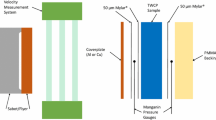Abstract
In a long uniaxial glass fibre/epoxy resin composite that is constrained by a rigid outer shell not to change its overall external dimensions, the transverse components of principal stress generated during cooling from the temperature of cure have been measured at various distances from the specimen ends. The radial (compressive) and hoop (tensile) components of stress in the resin between four fibres whose axes define the edge of a prism with square section are in excess of 6 and 100 MPa, respectively. In an identical specimen, 4 days of exposure to distilled water at 80° C was found to give rise to a tensile hoop stress of magnitude sufficient to cause fracture of the rigid outer shell.
Similar content being viewed by others
References
D. F. Adams, 2nd Annual Army Composite Materials Research Review, May 1979, University of Massachusetts.
A. K. Miller andD. F. Adams, Departmental Report UWME-DR-7011111, “Micromechanical Aspects of Composite Materials”, January 1977, Department of Mechanical Engineering, University of Wyoming, Laramie, Wyoming 82071.
A. J. Durelli andW. F. Riley, “Introduction to Photomechanics”, (Prentice-Hall Inc., Englewood Cliffs, New Jersey, 1965).
Author information
Authors and Affiliations
Rights and permissions
About this article
Cite this article
Cunningham, B., Sargent, J.P. & Ashbee, K.H.G. Measurement of the stress field created within the resin between fibres in a composite material during cooling from the cure temperature. J Mater Sci 16, 620–626 (1981). https://doi.org/10.1007/BF02402778
Received:
Accepted:
Issue Date:
DOI: https://doi.org/10.1007/BF02402778




